
Sketching NGC 6633
October 7, 2015As long-time readers will recall, I have been bully on the idea of sketching DSOs for a long time. I have been inspired by the careful observations and sketches of Doug Rennie and Terry Nakazono in particular. So I made up a blank observing form (which is now up on the sidebar here), printed out some copies, and decided to finally give it a shot. I was going to do M57 first, and kick off my much-discussed, long-delayed Suburban Messier project. But I’d just been emailing with Doug and he’d recommended NGC 6633 as a rewarding open cluster for visual observation, and as I was flipping around in my Pocket Sky Atlas I noticed that it was well-placed high in the southeastern sky.
I was rolling with the XT10. I figured that whatever target I went for, I’d want to capture as many background stars as possible, and the XT10 has much better light grasp and angular resolution than anything else I own.
I started at moderate magnification with the 8-24mm zoom but kept backing out to try to get more context for the cluster, and I ended up with my trusty old 32mm Plossl. The transparency here was appalling. The sky looked clear, in that there was no naked-eye-visible haze or clouds, but it was very humid, and all of that water vapor in the air was bouncing back the city lights like crazy. The sky was about as bright as I have seen it without actual clouds up there. Here’s a measure of how humid it was – all of my exposed stuff dewed up! I don’t think that has ever happened to me here in Claremont.
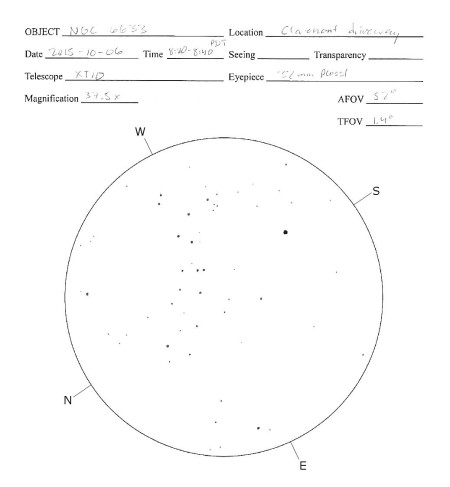
As far as my method – I was using a 0.5mm mechanical pencil and a click eraser. I started out by trying to frame the field of view with some bright ‘anchor’ stars and then interpolate between them to flesh things out. This proved frustrating – inevitably I’d get one region ‘starred in’ to my satisfaction and then see that its geometry was off compared to a neighboring section. So I did a fair amount of erasing and repositioning. On the first pass I was mainly trying to get the positions of the stars correct.
Then while I was still at the eyepiece I went back and ‘brightened’ up some of the stars by drawing over them with slightly larger circles. I tried to sort them into about five bins, from the bright star south of the cluster, through the brightest anchor stars, the major cluster members, the minor cluster members, to the barely-theres.
Finally, when I brought the drawing inside I touched up a few stars that were noticeably out-of-round.
So the drawing you see here is the ‘rough’ drawing, but with about three layers of revision layered on top. I don’t know if this is good practice or not, it’s just what I did this time, pretty much making everything up as I went along.
As for the cluster, NGC 6633 has a fairly recent nickname: the ‘Italy cluster’. Here’s a diagram from this blog, with my sketch inverted and rotated to match:
I can buy it. I wouldn’t have ever picked out that by myself, but I can see the shape in my drawing, and I didn’t know it was there when I was drawing it.
So, I have rather mixed feelings about all of this. While I was doing the sketch, all I could think about was how difficult it was, and how badly I was screwing it up. But I’m fairly happy with the result – it is at least recognizable as NGC 6633 – and I know that I know that cluster and the surrounding starfield a lot better now. Probably better than I know any other single object. I can’t think of another time that I invested so much time and energy on a single observing target.
Maybe this is the beginning of wisdom.
UPDATE October 26, 2015
Here are a couple of sketches of NGC 6633 sent along by Terry Nakazono with permission to post. Thanks, Terry!
From July 9, 2012.
From June 28, 2013.
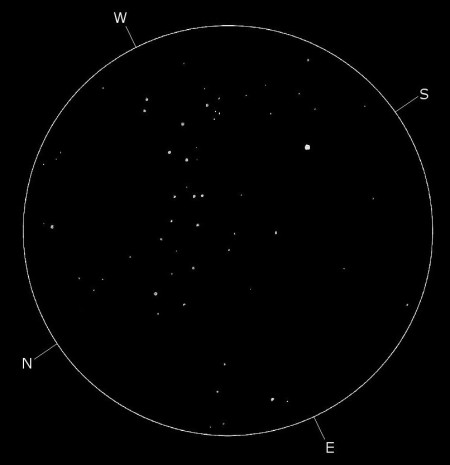
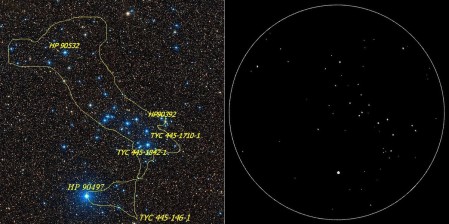
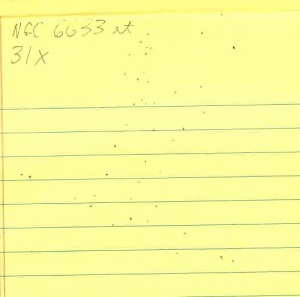
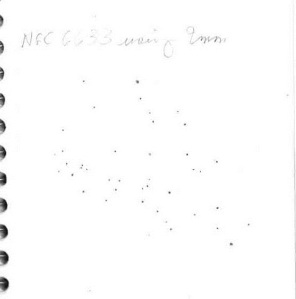
Well played, Matt!
“Italy cluster”. News to me, but in your sketch I can sure see it, in fact it’s one of the best examples of instantly seeing the shape that the name suggests. Now I need to go upstairs and flip mine around to see what it looks like. Somehow, I think it’s not going to be as close to the Italy boot shape as yours.
And speaking of this. It is so strange that you can go to a sketching site such as Deep Sky Archives and go to any object, say NGC 6633, and see a dozen sketches by different observers and no two even look REMOTELY alike. I mean, it looks like 12 different objects. Sue French turned me onto this site and I thought, Wow this will be great as I would have a sense of what pattern(s) to look for in future first time searches. Nope. If anything, more confusing. So I am not surprised that your sketch of 6633 would look different than mine or Terry’s . . . maybe WAY different. Yes, you were using a Dob and I a refractor, but the flipping should melt away most of the differences, but without even doing my flipping yet, I suspect that this won’t me the case. Now I am going to go back and re-do 6633 from scratch and see if it comes out any different.
Sketching, and giving it the time, patience and attention to detail as you’ve done here adds discipline to one’s observing routine and forces you to really study an object, rather than racing ahead to the next one, the one after that, and so on.
I’m curious as to others who are on board 10MA approach sketching and hope that your post here initiates an extended dialogue on the subject.
Doug
Actually, this isn’t bad. Missing a few stars at the top and not as close to defining the boot as yours, but elements are close. Now I am amped up to re-sketch 6633.
>
I actually observed (and sketched) 6633 twice using the same scope (Orion Sky Scanner) back in 2012 and 2013. The sketch from the earlier observation was done using 31.5x at Simi Valley (red zone) and closely resembles yours, showing the breadth of the cluster. The sketch one year later was done using 44.4x at Yucca Valley (orange zone) and doesn’t have the breath, but shows more depth (more stars) within the core of the cluster.
The earlier sketch was done on a yellow Office Max lined notepad and the later one on a white Mead lined notebook.
Terry,
I’d like to see the two sketches. Can you send them to Matt to post?
Doug
Hi Matt,
As a follow-up to the comments I made on this post, attached are the two crude sketches I did of NGC 6633, one on 7/19/12 and the other on 6/28/13.
Terry
Thanks for posting Matt – and thanks to Doug for asking me to send my sketches to Matt. Doug suggested that NGC 6633 was an open cluster suitable for visual observation – apparently I thought the same, as I sketched this object twice at two different time points.
Hi Terry.
Hey, these are excellent sketches!
Thanks for sending them to Matt. You and I have discussed sketching via email a couple of times in the past and you always seemed to sort of low key/downplay your sketching, hence I had the impression that you weren’t really into the process and just casually scrawled out some dots. Not so! Both of these sketches, the bottom one in particular, show a serious attention to detail, both in arrangement and varying point sizes and are really, really well-rendered. How long (about) did these take to do?
Yes, NGC 6633 is, as I said to Matt earlier, an open cluster that gets nowhere near the attention it should——every bit as interesting, in fact MORE so, than nearby IC 4665 (which gets all kinds of press, “Summer Beehive” and all) and IC 4756.
I did the same thing, that is 2 sketches of NGC 6633, just over a year apart, and there are differences.
I’d like to see more of your sketches, so maybe send me a few or send them to Matt to post. Maybe we can get him to open a sketching subforum on 10MA!
Well done!
Doug
It was just good to see that Matt’s and my impressions of NGC 6633 were similar – we both used reflectors, so it was easy to compare between the two.
Open clusters can be very time consuming – I’m guessing they both took about half-an-hour (or more). For me, what’s important is the arrangement – making sure that the stars are located relative to each other exactly as I see them in the eyepiece. It’s important that I’m able to corroborate what I’ve sketched with an image of the object found online.